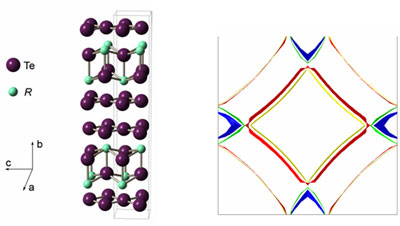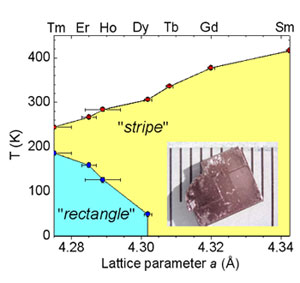A collaboration between scientists at SSRL and the department of Applied Physics at Stanford University has determined the phase diagram of a new family of prototypical charge density wave (CDW) compounds. These compounds have the chemical formula RTe3, where R represents a rare earth element from La to Tm. In research, the collaborators have used X-ray diffraction and resistivity measurements to determine the factors affecting the symmetry of the CDW state, specifically whether the CDW runs in one direction or two.

Charge density waves are a type of coupled electronic-lattice instability found in quasi-low dimensional materials. The driving force behind the instability is the reduction in kinetic energy of electrons in the material as a consequence of establishing a spontaneous periodic modulation of the crystalline lattice with an appropriate (often incommensurate) wave vector. The symmetry of the CDW state is very sensitive to the electronic structure of the host material.
In recent work reported in Physical Review B [1], the researchers from Stanford University (graduate students Nancy Ru and Kyungyun Shin and Professor Ian Fisher) teamed up with postdoc Cathie Condron and staff member Mike Toney from SSRL to determine the phase diagram of RTe3, a new family of prototypical CDW compounds. The crystal structure of these compounds is illustrated below; they are layered, weakly orthorhombic, and consist of double layers of nominally planar Te sheets separated by RTe slabs.
"Because these materials form for almost the entire rare earth series, they provide a fantastic 'toy box' to explore factors affecting CDW formation" says Fisher. In particular, the familiar lanthanide contraction (decrease in ionic radius with increasing nuclear charge across the rare earth period) provides access to an almost continuous range of 'chemical pressure'.

The resulting phase diagram, shown below as a function of the RTe3 in-plane lattice parameter a, is quite remarkable. Despite the almost 4-fold symmetry of the crystal structure and Fermi surface, a simple unidirectional ('stripe') CDW along c is stable across the entire rare earth series. However, for the heaviest members of the series (R = Dy - Tm), a second CDW is stabilized with a wave vector transverse to the first — a novel state with a 'rectangular' symmetry. This discovery [1] was surmised from the resistivity measurements in Fisher's lab and verified with high-resolution diffraction at SSRL Beam Line 7-2. "It is really the high quality of the RTe3 crystals that allow diffraction measurements" says Condron.
Why does this nominally tetragonal material adopt a 'stripe' phase? It turns out that a single wave vector does a much better job of reducing the kinetic energy of the electrons than two wave vectors. The variation in CDW transition temperature, Tc, (above which the CDW disappears) can be readily understood in terms of the effects of chemical pressure on the electronic structure. What stabilizes the additional 'rectangular' lattice modulation? The reduction in Tc of the 'stripe' phase leaves more Fermi surface available for a second CDW - in essence, the material 'rediscovers' its four-fold symmetry.
What else can be learnt from this remarkable behavior? Questions that the team is already investigating include the symmetry of CDW fluctuations above Tc (where there is still some remnant short range order), and the effect of disorder (dialed in by astute alloying on the rare earth site) on the symmetry of the CDW. More generally, the rare earth tritellurides are just one member of broader family of layered rare earth tellurides. Initial experiments at SSRL on closely related members of this family indicate that other surprises are waiting to be discovered. Furthermore, these materials provide a simple model of more complex materials that exhibit "charge ordering" phenomena, including high-temperature superconductors.
N. Ru, C.L. Condron, G.Y. Margulis, K.Y. Shin, J. Laverock, S.B. Dugdale, M.F. Toney, I.R. Fisher, Phys Rev. B 77, 035114 (2008).




